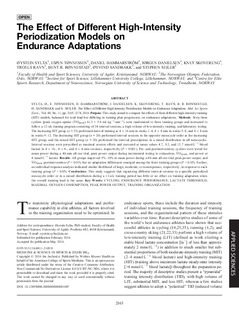| dc.contributor.author | Sylta, Øystein | |
| dc.contributor.author | Tønnessen, Espen | |
| dc.contributor.author | Hammarström, Daniel | |
| dc.contributor.author | Danielsen, Jørgen | |
| dc.contributor.author | Skovereng, Knut | |
| dc.contributor.author | Ravn, Troels | |
| dc.contributor.author | Rønnestad, Bent | |
| dc.contributor.author | Sandbakk, Øyvind | |
| dc.contributor.author | Seiler, Stephen | |
| dc.date.accessioned | 2017-06-07T10:26:48Z | |
| dc.date.available | 2017-06-07T10:26:48Z | |
| dc.date.created | 2016-10-12T15:35:06Z | |
| dc.date.issued | 2016 | |
| dc.identifier.citation | Medicine & Science in Sports & Exercise. 2016, 48 (11), 2165-2174. | nb_NO |
| dc.identifier.issn | 0195-9131 | |
| dc.identifier.uri | http://hdl.handle.net/11250/2444540 | |
| dc.description.abstract | Purpose: This study aimed to compare the effects of three different high-intensity training (HIT) models, balanced for total load but differing in training plan progression, on endurance adaptations.
Methods: Sixty-three cyclists (peak oxygen uptake (V˙O2peak) 61.3 ± 5.8 mL·kg−1·min−1) were randomized to three training groups and instructed to follow a 12-wk training program consisting of 24 interval sessions, a high volume of low-intensity training, and laboratory testing. The increasing HIT group (n = 23) performed interval training as 4 × 16 min in weeks 1–4, 4 × 8 min in weeks 5–8, and 4 × 4 min in weeks 9–12. The decreasing HIT group (n = 20) performed interval sessions in the opposite mesocycle order as the increasing HIT group, and the mixed HIT group (n = 20) performed the interval prescriptions in a mixed distribution in all mesocycles. Interval sessions were prescribed as maximal session efforts and executed at mean values 4.7, 9.2, and 12.7 mmol·L−1 blood lactate in 4 × 16-, 4 × 8-, and 4 × 4-min sessions, respectively (P < 0.001). Pre- and postintervention, cyclists were tested for mean power during a 40-min all-out trial, peak power output during incremental testing to exhaustion, V˙O2peak, and power at 4 mmol·L−1 lactate.
Results: All groups improved 5%–10% in mean power during a 40-min all-out trial, peak power output, and V˙O2peak postintervention (P < 0.05), but no adaptation differences emerged among the three training groups (P > 0.05). Further, an individual response analysis indicated similar likelihood of large, moderate, or nonresponses, respectively, in response to each training group (P > 0.05).
Conclusions: This study suggests that organizing different interval sessions in a specific periodized mesocycle order or in a mixed distribution during a 12-wk training period has little or no effect on training adaptation when the overall training load is the same. | nb_NO |
| dc.language.iso | eng | nb_NO |
| dc.publisher | American College of Sports Medicine | nb_NO |
| dc.rights | Attribution-NonCommercial-NoDerivatives 4.0 Internasjonal | * |
| dc.rights.uri | http://creativecommons.org/licenses/by-nc-nd/4.0/deed.no | * |
| dc.title | The Effect of Different High-Intensity Periodization Models on Endurance Adaptations | nb_NO |
| dc.type | Journal article | nb_NO |
| dc.type | Peer reviewed | nb_NO |
| dc.source.pagenumber | 2165-2174 | nb_NO |
| dc.source.volume | 48 | nb_NO |
| dc.source.journal | Medicine and Science in Sports and Exercise | nb_NO |
| dc.source.issue | 11 | nb_NO |
| dc.identifier.doi | 10.1249/MSS.0000000000001007 | |
| dc.identifier.cristin | 1391293 | |
| dc.description.localcode | Copyright © 2016 the Author(s). Published by Wolters Kluwer Health onbehalf of the American College of Sports Medicine. This is an open-access article distributed under the terms of the Creative Commons Attribution-Non Commercial-No Derivatives License 4.0 (CCBY-NC-ND), where it is permissible to download and share the work provided it is properly cited. The work cannot be changed in any way or used commercially without permission from the journal | nb_NO |
| cristin.unitcode | 194,65,30,0 | |
| cristin.unitname | Institutt for nevromedisin | |
| cristin.ispublished | true | |
| cristin.fulltext | original | |
| cristin.qualitycode | 2 | |

